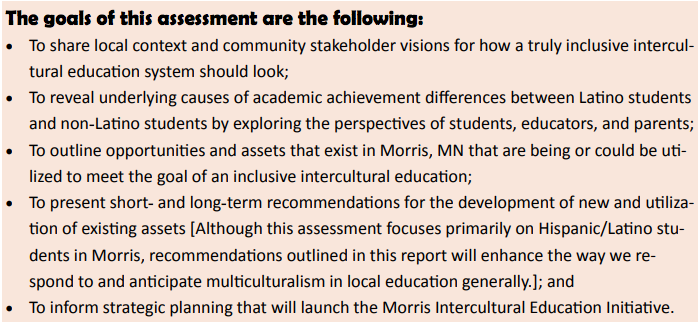Manolis, Argie, Cristina Ortiz, and Keni Zenner. “Morris Intercultural Education Initiative: A Community Needs and Assets Assessment.” Morris, 2014.
“We are more likely to hear about a Latino achievement gap than a success story. We often hear of generalized statistics, but rarely of local, context- and as-set-driven figures.”
The Morris Intercultural Education Initiative was a program compiled and executed by a large array of individuals from the University of Minnesota Morris in 2014. It also included information from many sources in and around our community such as the Morris Area School District, Community Education & Recreation office, Minnesota Literacy Council and other community groups. Dr. Cristina Ortiz, a beloved professor of Amy and myself, did much of the work on this project and has supplied us with an array of incredible resources for our project simply by conducting her own research both independently and with the help of her classes. This project is divided into chapters discussing the program itself, the differing national and local contexts of education, community based research, recommendations, and an appendices. If you take a look at the goals below and I’m sure you’ll see the importance of this study to our research.
One of the many goals of the assessment overall was to demonstrate the differences in native language and culture should be viewed as assets and an opportunity to create a positive, intercultural setting for relationship building and learning. Because of this specific goal, Amy and I are going to be able to dissect the community based research that has been done through the Office of Community Engagement at UMM as well as external research. Their research questions are clear and align much of the information Amy and I have been interested in pursuing while studying the Latino population here in Stevens County. The study includes best practices for the proposed programs, specific data from national and local research, and community perspectives. One thing it does exclude, that Amy and I should take into consideration, is data on Stevens County as a whole. We planned our research on Stevens County because so many people groups and industries here overlap between towns. This focuses on Morris which excludes some of the other school districts in Stevens County.
This resource, although specific to Morris, could be beneficial to anyone looking to understand more about grassroots education or community involvement in their project. It is also a very clear and organized piece of literature that could help others understand the layout of anthropological research studies.


Solid primary source for any investigation of Hispanic migration to Morris — the specificity is potentially quite telling. Here you have a parallel set of data, not perfectly matching of course, but perhaps very helpful, for the comparative side of the project.
Wonder what type of educational information exists for the Apostolics?
Your inclusion of the quote concerning success and achievement is important. Success is certainly cultural and socioeconomic interpretation. Thus, relatively speaking Mexicans might consider themselves quite successful in community building, support of religion, and ability/opportunity to provide for family. This sets up for not only an interesting study but one with relevance to the target community.